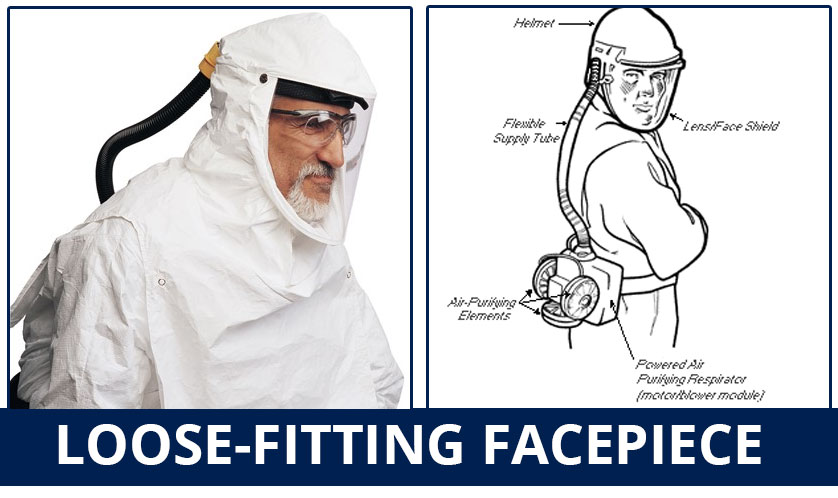
The control of potential health hazards caused by breathing air contaminated with harmful levels of chemical, physical or biological agents shall be accomplished as far as feasible by accepted engineering control measures. When effective engineering controls are not feasible, or while they are being instituted, appropriate respiratory protection shall be used.
This program impacts all employees, students, volunteers, and contractors (working under direct Auburn University supervision), who are required, or elect, to wear respiratory protection as part of their employment. Only respirators which are applicable and suitable for the purpose intended shall be used. Individuals who voluntarily wear filtering face pieces (dust masks) are covered by this program only as addressed in the Voluntary Use section.
STEPS FOR RESPIRATOR USE
1. Request for Respirator Use
- User completes and submits an online respirator user request here.
- All new respirator users
- Annual tight-fitting respirator users
- Users with changes to their job duties and/or physical attributes that could result with an improper fit.
- The request will be reviewed by RMS to determine if respirator use is warranted, to verify that the appropriate respirator is selected based on the listed hazard, and to determine if a medical evaluation is required. Medical evaluations are typically only required initially.
- Following the review, the completed and approved request is forwarded to the user.
2. Medical Review
- If RMS determines a medical evaluation is required the user will receive the Respirator Medical Questionnaire from RMS to submit directly to an occupational physician.
3. Training
- Training is required for initial use and annually thereafter for all respirator users. Training will be provided by RMS via email once medical approval for respirator usage has been obtained.
4. Fit Test
- Fit tests must be completed for initial use and annually thereafter with the respirator model the individual will be using. RMS will set-up time with user after user submits online request and after completion of medical questionnaire if applicable and training.
PLEASE USE THE TABLE BELOW AS A GUIDE FOR TIMELINE OF REQUIREMENTS

Before selecting the proper respirator and filter for the job, be sure to first:
- Identify the respiratory hazard
- Evaluate the hazard
- Consider engineering controls
Respirators can be tight fitting or loose fitting as outlined below.


Review the Respirator Selection Guide for additional details on selecting the proper respirator or for information contact RMS at (334-734-1715).
All fit testing is provided through RMS. If a position is filled that requires the use of a respirator, please submit a request on the RMS Respirator Program Webpage to set-up a medical evaluation and fit test. A record of the fit test shall be kept by RMS and retained until the next fit test is administered.
Fit testing of tight-fitting atmosphere-supplying respirators and tight-fitting powered air- purifying respirators (PAPR’s) shall be accomplished by performing quantitative or qualitative fit testing in the negative pressure mode.
Loose fitting, hood-style PAPRs do not require fit testing.
Each person issued a respirator shall inspect the respirator prior to each use to ensure that it is in good condition. This inspection shall include a check of the tightness of the connections and the condition of the facepiece, headbands, valves, and cartridges. The mask itself shall be inspected for signs of deterioration. If any defects are noted, the wearer shall repair the respirator. Replacement parts shall be approved for the specific respirator being repaired. If the repair cannot be made immediately, a replacement respirator of the same model and size shall be provided until such time as the repair can be made.
Respirators worn by a single person need to be cleaned and disinfected once a day or as often as needed to keep it sanitary, while respirators shared among employees must be cleaned and disinfected after each individual’s use.
- First remove any filters, cartridges or canisters. Disassemble the face piece and remove the straps.
- Inspect the tightness of all connections and the condition of the various pieces such as straps, tubes, diaphragms and cartridges. Any defective parts should be repaired or replaced by a qualified person.
- Wash all parts of the respirator with a detergent recommended by the manufacturer and warm water. A bristle brush will remove excess dirt.
- Use warm water to rinse all of the parts. Be sure to rinse off all of the detergent because the residue can dry on the rubber and crack it or corrode metal.
- After thoroughly rinsing and draining, the parts should be immersed in a disinfectant of bleach, iodine or cleanser approved by the respirator manufacturer for two minutes. Once removed, the pieces should be completely rinsed, drained and then dried, either with a lint-free cloth or air-dried.
When not in use, respirators shall be placed in individual sealable containers to protect them from contamination. Storage shall be in designated storage areas in such a manner that the respirator will not be distorted or damaged. Storage areas to avoid include workbenches, tool boxes, or hanging from hooks out in the open workroom.
Upcoming Events
| View All Events |





